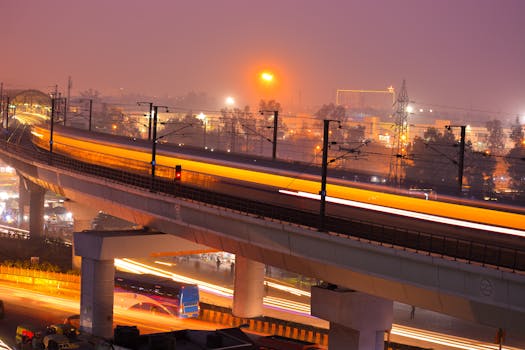
**
Dwarka Expressway Pioneers AI-Powered Traffic Management: Detecting 14 Violations to Ease Congestion in Delhi-NCR
Delhi-NCR's notorious traffic woes are set to receive a significant technological upgrade with the implementation of India's first AI-based traffic management system on the much-anticipated Dwarka Expressway. This innovative system promises to significantly reduce congestion and enhance road safety by automatically detecting 14 different types of traffic violations. The project, a testament to India's burgeoning smart city initiatives, is poised to become a model for other major metropolitan areas grappling with similar challenges.
A Technological Leap Forward in Traffic Management: Beyond Traditional Methods
For years, Delhi-NCR has relied on manual traffic enforcement, a system often overwhelmed by the sheer volume of vehicles and prone to inconsistencies. The new AI-powered system on the Dwarka Expressway represents a paradigm shift, leveraging advanced technology to improve efficiency and effectiveness. Traditional methods, like relying solely on traffic police officers, are slow, labour-intensive, and susceptible to human error. This new system addresses these shortcomings by offering:
- 24/7 Monitoring: Unlike human officers, the AI system operates continuously, providing uninterrupted surveillance and detection of violations.
- Objective Enforcement: The AI system eliminates human bias, ensuring fair and consistent enforcement of traffic rules.
- Real-time Data Analysis: The system collects real-time data on traffic flow, congestion patterns, and violation types, enabling authorities to make informed decisions about traffic management strategies.
- Improved Response Times: Automatic alerts for violations allow for quicker responses and potentially prevent accidents before they occur.
The 14 Traffic Violations Targeted by the AI System
The AI system on the Dwarka Expressway is designed to detect a wide range of traffic violations, contributing to safer and more organized roadways. These include:
- Over-speeding: Detecting vehicles exceeding the speed limit.
- Wrong-way driving: Identifying vehicles traveling against the designated traffic flow.
- Red light jumping: Automatically recording vehicles passing through red traffic signals.
- Lane cutting: Identifying vehicles abruptly changing lanes without signaling.
- Overtaking in no-overtaking zones: Detecting vehicles overtaking in restricted areas.
- Not wearing seatbelts: Identifying drivers and passengers not wearing seatbelts.
- Using mobile phones while driving: Detecting drivers using mobile phones.
- Triple riding on two-wheelers: Identifying instances of more than two people riding a two-wheeler.
- No helmet: Detecting two-wheeler riders without helmets.
- Ignoring traffic signals: Detecting drivers ignoring any form of traffic signals.
- Parking violations: Detecting illegally parked vehicles.
- Tailgating: Identifying vehicles driving too close to the vehicle in front.
- Unnecessary honking: Detecting excessive and unnecessary use of vehicle horns.
- Violation of speed limits in school zones: Detecting speeding in areas near schools.
Dwarka Expressway: A Smart City Showcase
The Dwarka Expressway, already a significant infrastructural project, is further enhanced by the integration of this cutting-edge AI-powered traffic management system. This integration solidifies its position as a flagship project for smart city development in India. The expressway is strategically located, connecting major areas of Delhi-NCR, and the improved traffic management will not only benefit commuters using the expressway itself but also ease congestion in surrounding areas.
Impact on Commuters and Road Safety
The expected impact of this AI-based system is significant. By detecting and addressing violations promptly, the system aims to:
- Reduce accidents: Lowering the incidence of accidents caused by traffic violations.
- Improve traffic flow: Creating smoother and less congested roadways.
- Enhance road safety: Providing a safer environment for all road users.
- Reduce travel time: Enabling faster commutes for drivers.
- Increase efficiency: Improving the overall efficiency of traffic management in the region.
Challenges and Future Prospects
While the implementation of this technology represents a major step forward, challenges remain. Ensuring data privacy and security, addressing potential technical glitches, and integrating the system with other traffic management initiatives are crucial for long-term success. However, the potential benefits outweigh these challenges, paving the way for similar deployments across other Indian cities. The Dwarka Expressway project serves as a powerful demonstration of how AI can revolutionize urban traffic management, setting a precedent for future smart city initiatives nationwide. The future will likely see increased integration of AI and other technologies in traffic management, leading to smarter, safer, and more efficient roads across the country. This AI-powered system on the Dwarka Expressway isn't just a technological marvel; it's a testament to India's commitment to building smarter and safer cities for its citizens. The success of this initiative could inspire similar projects across the nation, significantly improving the traffic situation in other major metropolitan areas battling similar congestion problems. The data collected will also be instrumental in future urban planning and infrastructure development, contributing to a more sustainable and efficient transportation system.




















